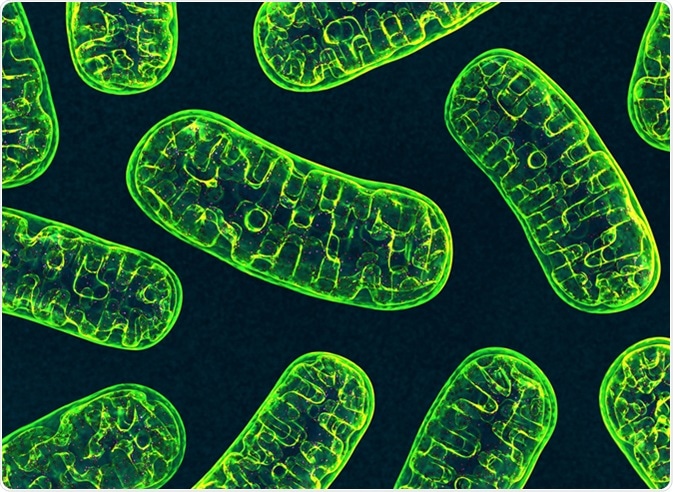Mitohormesis is a process wherein reactive oxygen species (ROS) produced by mitochondria at a low concentration act as signaling molecules to initiate a cascade of cellular events that ultimately protect the cells from harmful effects.
What is Mitohormesis?
Mitochondria are important cellular organelles that act as the cellular ‘power house’. Mitochondria generate ATP as a source of energy through a process called oxidative phosphorylation. During this process, mitochondria also produce ROS as by-products. In the initial years of discovery, ROS were believed to have only harmful effects in term of inducing oxidative damages to various cellular components, including proteins, lipids, and DNA.

Mitochondria. Image Credit: 3d_man / Shutterstock
However, recent scientific evidence has clearly indicated that ROS can also be beneficial for the cells. In response to mild cellular stress, mitochondria generate low levels of ROS, which in turn act as signaling molecules and protect the cells from further damage by initiating an adaptive response (stress defense mechanism). This process is known as mitochondrial hormesis or mitohormesis.
Mechanism of Mitohormesis
Several endogenous and exogenous stresses can significantly disrupt normal mitochondrial functioning. These mitochondrial disorders subsequently activate cytoplasmic signaling pathways through a series of complex mechanisms that may involve mitochondrial ROS. Upon activation, these cytoplasmic signaling pathways cause transcriptional alterations of nuclear DNA, which subsequently result in the activation of various cytoprotective mechanisms (adaptive response). Therefore, alterations in cytoplasmic signaling and subsequent nuclear response are the key features of mitohormesis.
A wide range of internal and external events may actively participate in inducing mitochondrial disruption and eliciting cellular responses. Such events include exposure to environmental toxins; disruption of the mitochondrial electron transport chain; accumulation of misfolded proteins in mitochondria; stalled mitochondrial ribosomes; and alteration in cellular metabolic pathways.
The adaptive responses that are the fundamental basis of systemic defense mechanisms include increased mitochondrial biogenesis; increased antioxidant defense mechanisms; changes in metabolism; increased detoxification of xenobiotics; and increased expression of mitochondrial protein chaperons. All these responses act in synergy to delay the aging process, to promote longevity, and to reduce or delay the onset of many age-related disorders.
How Mitochondria Trigger Cytoplasmic Signaling
Mechanisms by which mitochondria activate cytoplasmic signaling pathways are still poorly understood. Some mechanisms that may be involved in this process include: alteration of mitochondrial membrane potential to induce ROS generation and/or facilitate the recruitment of various mediators, including ROS, on the mitochondrial membrane; altering cytoplasmic calcium concentration as well as calcium-mediated signaling pathways by importing calcium from the cytosol into the mitochondrial matrix; and altering the levels of cellular metabolites, including NAD+/NADH and acetyl-CoA, which act as cofactors to modulate activities of many enzymes, such as sirtuins, histone acetyltransferase, and poly (ADP-ribose) polymerase (PARP). Besides these processes, mitochondrial structural alteration through the fission and fusion mechanisms can also regulate cellular signaling pathways by altering the rate of metabolic activities and ROS production.
Importance of Mitohormesis
As evidenced by its definition, mitohormesis is a phenomenal mitochondrial event by which a mild stress can actually protect living organisms from detrimental outcomes of subsequent larger stress. It is now clearly evidenced from scientific findings that a transient increase in ROS level and associated mitochondrial responses are beneficial in terms of promoting longevity.
Interestingly, mitohormesis also contributes significantly to the onset and progression of metabolic diseases, such as obesity and diabetes. For example, nutritional overload, which is one of the main causes of obesity, increases mitochondrial respiration, which subsequently elevates ROS production. Since ROS are strongly related to the development of diabetes, any alteration in mitochondrial hormesis can make an obese person more susceptible to diabetes.
Another classical implication of mitohormesis is that many plant products with medicinal values are often known to provide cytoprotection in humans by promoting mitohormesis. It is known that these plants naturally synthesize their active compounds when under stressful conditions. In other words, active plant compounds synthesized under stress can actually induce mitohormesis in other species and provide cellular protection.
Further Reading
Last Updated: Sep 17, 2018